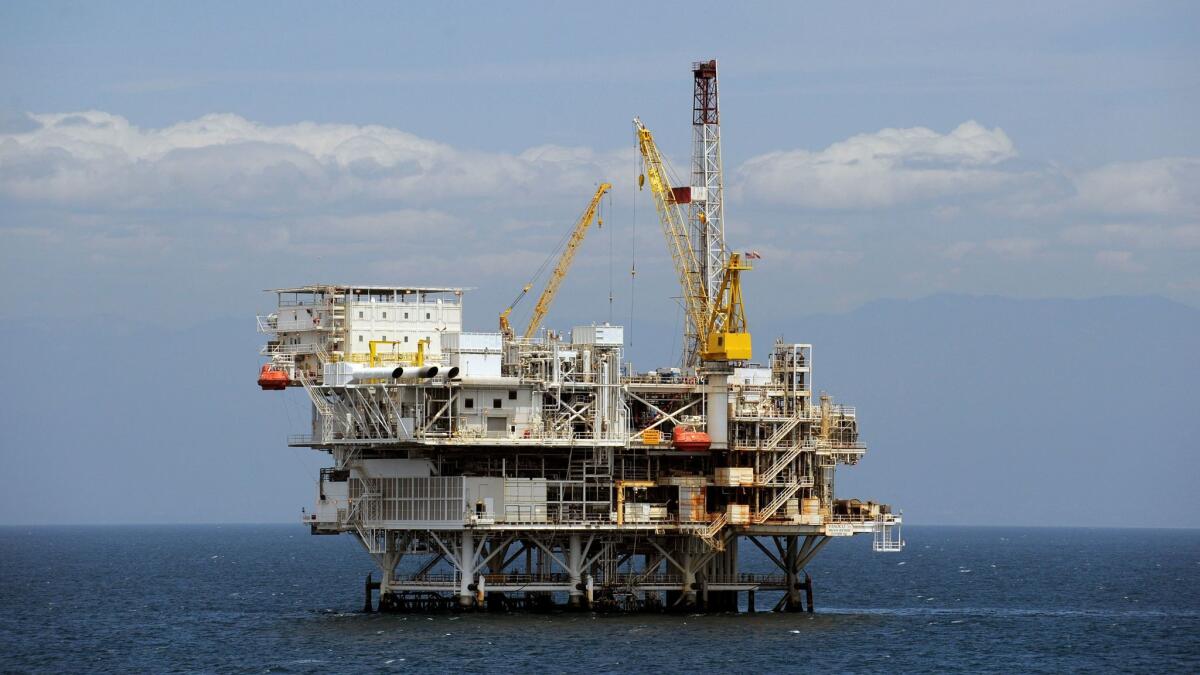Op-Ed: The Trump administration is an oil junkie — and it’s looking to score off California’s coasts

- Share via
President Trump signed an executive order Friday aimed at expanding offshore oil drilling in U.S. waters, including areas in the Atlantic and Arctic Ocean made off-limits by President Obama. For good measure, and no doubt as a poke in the eye to a state that voted overwhelmingly against him, his directive includes the possibility of new drilling leases off the California coast.
The idea, clearly, is to open up U.S. seas not yet tapped like the Gulf of Mexico — America’s energy sacrifice zone — as if the nation were a junkie searching for uncollapsed veins. Don’t blame me for that metaphor. It was George W. Bush who in early 2006 said, “America is addicted to oil.” Bush, his vice president and his national security advisor all had backgrounds in the oil sector. Now, President Trump’s secretary of State is the former CEO of Exxon Mobil, the world’s largest dealer of petroleum.
The offshore-oil order followed another executive order, signed by Trump on Wednesday, directing Secretary of the Interior Ryan Zinke to “review” the Antiquities Act. That law, established by President Teddy Roosevelt in 1906, allows presidents to create national monuments, including marine preserves where oil drilling, commercial fishing and mining are not allowed.
Zinke, who identifies himself as a “Teddy Roosevelt conservationist,” has called for opening up America’s public lands and waters to hunting, fishing and drilling. Never mind Roosevelt’s position: “The rights of the public to the [nation’s] natural resources outweigh private rights and must be given ... first consideration.”
Since a failed Reagan administration bid to reopen California’s waters to drilling, oil leasing off our coast has been something of a political third rail.
In the fine print, Trump’s executive order on Friday also calls for a review of safety rules, put in place after BP’s Deepwater Horizon disaster, governing the mechanics of blowout preventers, drilling bores, workplace safety protocols and other systems that have failed in the past. This is another in the administration’s attacks on regulations related to environmental protection. Given the offshore industry’s history of disasters — from Summerland, Calif., blowouts in the 1890s to the infamous Santa Barbara oil spill of 1969 to Deepwater in 2010 — granting more leases while reducing regulations is guaranteed to result in not only more drilling but more spilling.
The debate over coastal drilling used to be largely about energy production versus marine pollution. Today, however, we know that the oil industry’s product, used as directed, overheats our planet and acidifies our seas. A 2015 study in the peer-reviewed journal Nature suggested that 33% of known oil reserves, along with 82% of global coal reserves, must be left in the ground and under the seabed if we are to avoid more than a 2-degree Celsius rise in global temperature, the safety limit set by the world’s nations.
We’re already living in what I call the greenhouse century. Tens of thousands of people have died in hurricanes and typhoons, wildfires, mudslides, expanding tropical-disease vector zones, droughts and drought-linked wars in Rwanda, Syria and South Sudan. Island nations are in legal negotiations over the fate of their submerging lands. And following the three hottest years on record — 2014, 2015 and 2016, when one-fifth of the Great Barrier Reef’s coral died — the certainty of greater disasters to come is undeniable.
Renewable energy — not more drilling in our coastal waters — is the only sane way forward, a route to a still overheated but not civilization-threatening climate future. To get there, the president would have to remove his undersized thumb from the scales and let the U.S. post-carbon market, particularly in California, catch up with the green energy industrial expansion of China and Germany.
The public outrage caused by dying, oil-coated seabirds and fouled Santa Barbara beaches in 1969 helped start the environmental movement. Since the 1980s and a failed Reagan administration bid to reopen California’s waters to drilling, oil leasing off our coast has been something of a political third rail, despite the power of the industry. In most beach towns, any attempt to transport oil from federal waters to refineries and storage facilities onshore has to be approved by a vote of the people — and the people don’t want another spill.
Trump’s executive order can’t change things immediately, not least because the current price of oil makes offshore drilling much less attractive than it used to be. Nonetheless, Californians have a legacy to protect. We should heed my favorite slogan from the March for Science that took place on Earth Day: “While the oceans are rising, so are we.”
David Helvarg is executive director of Blue Frontier, an ocean conservation and policy group. His latest book is “The Golden Shore — California’s Love Affair with the Sea.”
Follow the Opinion section on Twitter @latimesopinion and Facebook
More to Read
A cure for the common opinion
Get thought-provoking perspectives with our weekly newsletter.
You may occasionally receive promotional content from the Los Angeles Times.









